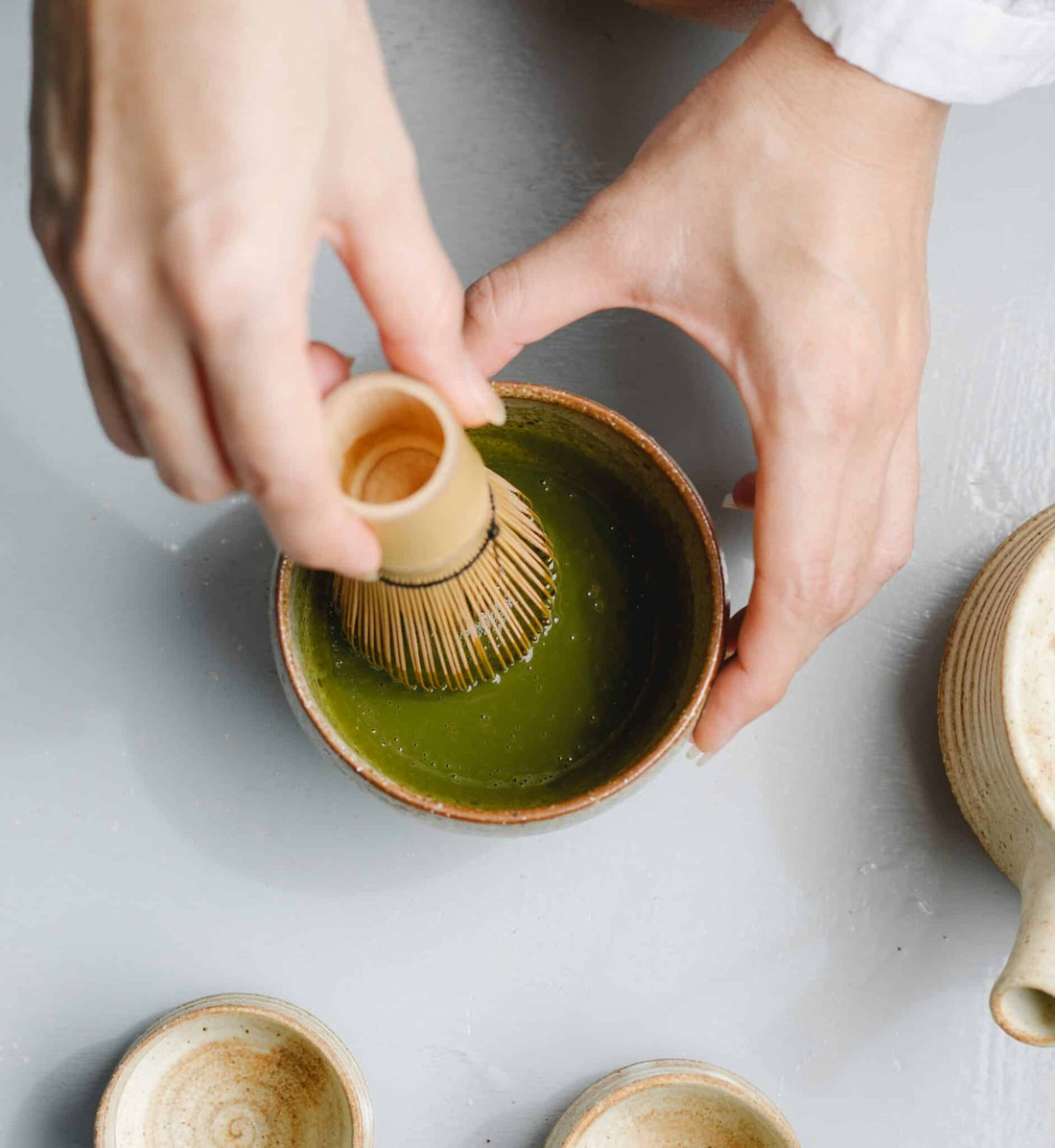How to Make Matcha
Before we learn how to make matcha, we find it easiest to start your journey by asking "What is Matcha?" Simply put, the word Matcha is a combination of the Japanese words ‘matsu’ meaning rubbed or ground and ‘cha’ meaning tea. So Matcha is ground tea. Etymology aside…what is it exactly?
Table of contents
What is Matcha?
When you think about Matcha, your first thought is something along the lines of ‘that weird green drink that everyone posts about on Instagram.’ You’re right, Matcha is one of the most aesthetically pleasing teas but it is so much more! Matcha is a powder made from green tea leaves, of the Camellia Sinensis plant, and since it is made from the whole leaf the benefits of consumption become tenfold when compared to drinking a cup of green tea. It can be considered a superfood since the antioxidant properties are astounding, with about 100 times more antioxidants (according to some research) than a cup of steeped green tea – that is six times the amount of the antioxidants in a serving of goji berries.

Matcha also contains a powerhouse combination of L-theanine and caffeine which work together in a slow-release process to give you a consistent and lasting amount of energy and will not result in caffeine jitters. However, do not get carried away! We recommend consuming only one drink a day (this could be one to three servings depending on the amount of matcha used) due to the long-lasting effects on your energy levels. Matcha is also rich in fiber, chlorophyll (a powerful detoxifier), vitamin C, selenium, chromium, zinc, potassium, and magnesium. Other health benefits include: a metabolism boost, it may aid in lowering cholesterol and blood sugar, and enhancement of mood and concentration. However, while the benefits of Matcha are numerous, due to the powdered form, preparation method is a little different and can seem intimidating. The most important characteristic of Matcha to remember is that the goal is to suspend the powder in water which will allow you to avoid a clumpy drink or a lot of green sludge at the bottom of your cup. For this reason, the powder is typically whisked or frothed so that you may achieve the right consistency. To help alleviate any intimidation, here are a few ways to prepare a cup of matcha that is perfect for your daily ritual and the ‘gram.
All three of the following methods work great with Happy Turtle Tea’s Organic Raspberry Vanilla Matcha which combines high-quality matcha with natural raspberry flavor, the sweet natural flavor of vanilla, and organic cane sugar. The sweet and tangy flavor of raspberries combined with the smooth vanilla results in a refreshing taste well-suited for hot or iced matcha drinks!
How to make matcha:
For the beginner
At Happy Turtle Tea we are firm believers that you do not need a lot of fancy equipment to have a great cup of tea and so we would like to offer a simple and effective way to try Matcha in your normal life. Using a mason jar allows you to quickly make this recipe anywhere and allows for easy clean-up!
What you will need:
- a mason jar (8oz or 16oz sizes work great)
- hot water, 165°-170°F
- 2 tsp Matcha
- Sugar (if desired)
Directions:
- Add 6-8oz of water to the mason jar, be careful to avoid burning your fingers
- Add Matcha (and sugar)
- Screw the mason jar lid on tightly
- Shake vigorously for 30-60 seconds
- Tip: check to make sure the matcha has been suspended properly – hold it still for a moment, if a lot of powder settles to the bottom of your mason jar you should shake it for 15 more seconds. If there is only mild settling of powder then you are good to go!
- Let cool for a minute and then enjoy!
For the ritual obsessed, the traditional way
Traditional preparation calls for a little more time and muscle on your part! This is our preferred method of preparation simply due to the process. It can be calming to follow a morning ritual, whether you are making coffee or tea in the morning. So, if you have the time on your hands and the desire to try the traditional method, give this a try!
What you will need:
- A matcha bowl OR a regular flat-bottomed bowl
- A bamboo whisk
- (optional) a fine-mesh strainer
- hot water, 165°-170°F
- 2-3 tsp Matcha
- Sugar (if desired)
Directions:
- Warm the bowl first with a small amount of the hot water and dip the whisk in to allow water to soak the bamboo tips, then discard this water
- Scoop 2-3 tsp of Matcha into the mesh strainer and gently shake the strainer to sift the powder into the bowl. This step is optional, but it does help to keep the powder from clumping
- Once the powder has been sifted add sugar if desired
- Add 6-8oz of hot water to the bowl
- Whisk vigorously for 30-60 seconds – as you whisk you will get large bubbles at the top of your bowl at first, but by the end of your whisking process the bubbles should be much smaller
- Pour your matcha into a small mug or you can drink it directly from the bowl!
- Tip: rinse your matcha whisk with warm/hot water (no soap) and allow the bamboo to air dry
For the enthusiast who is looking for something special:
A Lavender Matcha Latte
What you will need:
- A matcha bowl OR a regular flat-bottomed bowl *
- A large mug
- A bamboo whisk* or milk frother
- You can prepare the Matcha either way described above but this will use a milk frother!
- (optional) a fine-mesh strainer
- hot water, 165°-170°F
- 2-3 tsp Matcha
- ½ cup of water
- ½ cup sugar
- Small saucepan
- ¼ or ½ cup dried lavender – depending on your desired strength
- 8-12oz milk, dairy or plant-based
Directions:
How to make the lavender simple syrup:
- On the stove, add ½ cup of water and ½ cup of sugar together in a small saucepan, over medium heat
- Slowly stir the mixture until the sugar has dissolved
- Add ¼ or ½ cup of dried lavender
- Turn the heat to low and allow the mixture to simmer for 20 minutes, keep an eye on it!
- Once it has cooled, strain out the lavender and pour the mixture into a lidded container – a small mason jar works great!
- Tip: if you want to make just a single serving, use 1 tablespoon measurement for water and sugar, and 2 teaspoons of dried lavender
For the matcha latte:
- Heat your milk in a microwave-safe mug or on the stove first and then pour into your preferred mug, set aside
- Warm the bowl first with a small amount of the hot water and dip the whisk in to allow water to soak the bamboo tips, then discard this water
- Add 6oz of hot water to the bowl and 1 tablespoon of your lavender simple syrup
- Scoop 2-3 tsp of match into your bowl
- Use a hand-held milk frother to mix your matcha for 30-60 seconds
- Once the powder has been suspended in the water, rinse the milk frother with water
- Grab your mug with warmed milk and use the hand-held milk frother to froth the milk
- Pour your matcha and lavender simple syrup mixture into your mug of freshly frothed milk and enjoy!
We hope that this has helped to clear the mystery surrounding how to make matcha. If you are new, do not feel pressured to buy a lot of tools because you can enjoy matcha with what you already have in your kitchen. If you end up loving this new way to enjoy tea, we highly encourage that you give the traditional recipe a chance – it can really help give calm to your mornings and set you up for the day. For those who already love matcha, or will soon, give the latte a shot (regular or lavender)!
Some Matcha lovers may also find themselves wanting to add a little bit of sugar to the rest of their tea. So don't hesitate to try our Raspberry Vanilla Matcha Sugar! Hand-crafted by us, to take your tea drinking experience to new heights.
Just remember, Happy Turtle Tea is here for you and your continued tea enjoyment! Let us know what kind of tea-related blog posts you would like to see in the future.
Frequently Asked Questions About Matcha:
Yes! Like all tea, matcha comes from the Camellia Sinensis plant. However, true matcha is made from tea leaves cultivated in Japan.
Matcha is made from tea leaves that have been de-stemmed, de-veined, and ground to achieve the fine powder. This results in a beautiful green matcha that is nutrient-dense.
YES! Matcha is considered a superfood for being nutrient-dense (since the powder is made directly from the tea leaf) and is remarkably high in potassium, iron, magnesium, and fiber. In addition, it is low in calories! One cup is equivalent to drinking 10 cups of green tea, so keep this in mind if you have limited access to tea during the day!
Yes, but only half the amount of caffeine that is in a cup of coffee. Don’t let this fool you because the combination of caffeine and L-theanine in matcha allows for the slow and consistent release of caffeine into your system. This keeps the jitters at bay and will help you through the whole day instead of just your busy morning.
The grading and price of matcha is a direct result of the production process and the type you buy. Since matcha is made from young tea leaves it requires careful cultivation and, proper shading. Not to mention the fact that Japan has finite terroir for cultivation. The best matcha is harvested by hand and many producers still use ancient leaf grinding techniques which not only adds to the overall umami-ness but also increases the costs to the consumer.
The highest grade of matcha is considered ceremonial grade and has a brilliant green color and is more earthy in flavor. Culinary grade is lighter in color, less earthy in flavor, and often used for the lattes at your favorite coffee shops. Give both a try and decide which one is your favorite. However, if you find one that is dull in color, and bitter in taste, pass it by.
Store matcha just like you store loose leaf tea – in an air-tight and opaque container (one that does not allow sunlight to hit the powder). Keep away from heat, moisture, and light to ensure quality as long as possible.


